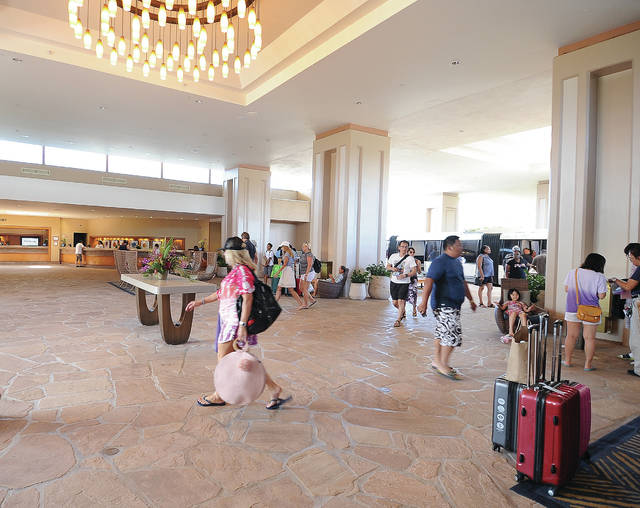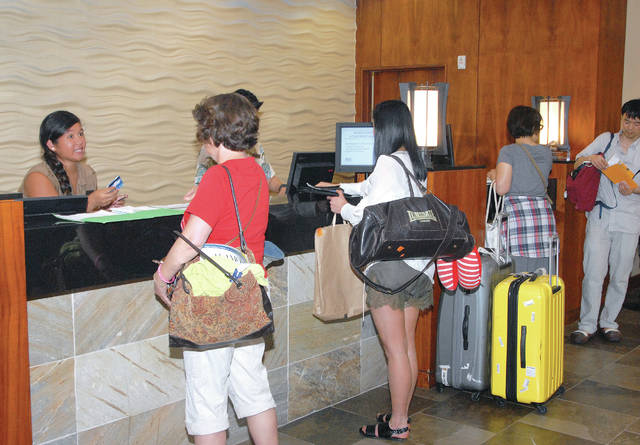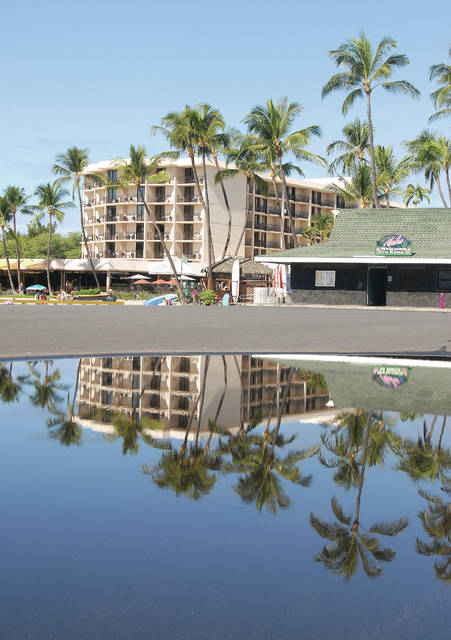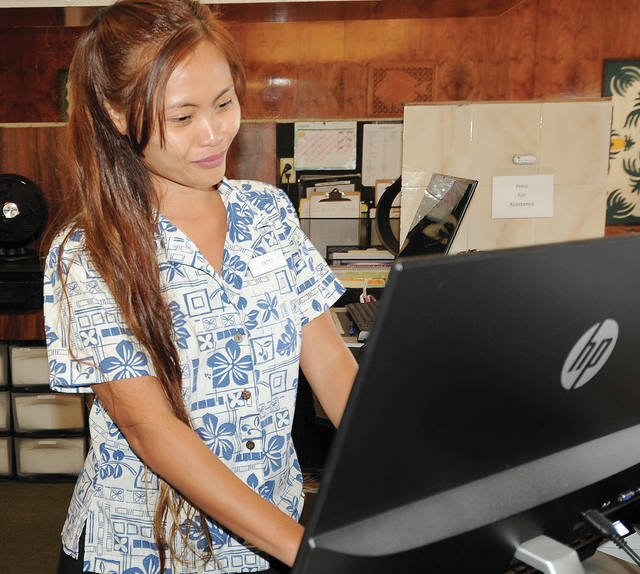KAILUA-KONA — Hawaii’s hotel occupancy rates reached an all-time high for 2018’s first quarter at 82.9 percent. But there’s more than meets the eye with the increasing digits.
Statistics reported by the Hawaii Tourism Authority indicate Hawaii Island is pulling its share in the boost, holding the second highest hotel occupancy rate of all four Hawaii counties.
Oahu led the way this quarter at 84.3 percent, Hawaii Island trailing close behind at 82.6 percent. Kauai at 81.1 percent and Maui at 80.2 percent followed.
During 2017, the island saw an occupancy rate of 74.4 percent, up from 68.8 percent in 2016, according to state Department of Business and Economic Development databooks. Since 2000, the island’s lowest occupancy rate was 54.5 percent during 2009, in the wake of the Great Recession of 2008.
Statewide, hotel occupancy has increased by more than 20 percent in the past six years alone.
On Hawaii Island, revenue per available room increased 14.7 percent to $243.05, and the average daily rate rose 11.4 percent to $294.22 over last year.
Rate inflation
“It could be inflated slightly,” said Ross Birch, executive director of the Island of Hawaii Visitor’s Bureau on the climbing digits, citing lower hotel inventory as a potential cause of the hike.
The old Keauhou Beach Hotel closed in 2012, and the Pagoda Hilo Bay Hotel shuttered its doors in 2017, resulting in a dip in total room inventory on the island.
The fewer rooms could, in part, be contributing to the swelling occupancy rates.
“Certainly, in terms of occupancy percents, the reduction in inventory would have an impact,” said Craig Anderson, vice president of Operations at Mauna Kea Resort.
Hotel inventory on the Big Island is expected to keep its downward trend, with the Mauna Lani Bay Hotel closing for a 14-month, $100 million renovation in October.
But decreased inventory isn’t just an on-island factor.
Craig said “the unfortunate hurricane activity in the Caribbean” has also carried influence, drawing additional traffic to the Hawaiian islands.
Island access
However, according to Birch, a mixed bag of factors is prompting the robust rates.
“It’s a combination of increased visitors from all markets. East and West United States to international,” he said.
And visitor levels are surging, as reported by the HTA. Statewide, visitors increased 9.4 percent this quarter versus last year with 2.47 million arrivals.
The Big Island hosted 495,558 arrivals in 2018’s first quarter, 12.8 percent more arrivals than last year.
In March, Hawaii Island visitor arrivals increased 25 percent from Japan, 18.3 percent from the U.S. East, 9.9 percent from the U.S. West, and 9.4 percent from Canada.
Central to this influx in visitors is flight access to the island.
“We’re seeing increased demand for the Island of Hawaii, certainly lots of new airlift, which is the only way you can get here,” said Anderson.
HTA detailed that air seat capacity to Ellison Onizuka Kona International Airport at Keahole rose 30.25 percent this past quarter from a year ago. This spike is partly due to the direct service from Tokyo’s Narita Airport that commenced last September, and more seats added from Vancouver, Canada.
Domestic carriers also expanded air service to Hawaii Island from Dallas, Los Angeles and San Francisco.
And when it comes to visitor spending, the increased access to the Big Island is evident.
Released statistics from the HTA revealed that visitor spending on the island rose 13.5 percent this past quarter from last year to $772 million.
Statewide, visitor spending increased 10.1 percent to $4.82 billion, compared to the first quarter of 2017.
Branding big
But increasing access and propelling demand go hand in hand, explained Birch.
In other words, the more people want to visit the island, the more reason to make the island reachable.
And to spark demand, marketing is key, explained Joan Harvey, marketing specialist at the Fairmont Orchid Hawaii.
“We’re really understanding our story a little better. It’s not just a volcano, there are so many other things on the island,” said Harvey. “It’s more awareness (about the island).”
Birch agreed that marketing plays a vital role in Hawaii Island hotels’ success.
“We actually intentionally changed our name of the island, branding to the Island of Hawaii has been somewhat new in the market,” said Birch, referring to the 2016 name change of the Big Island Visitors’ Bureau to Island of Hawaii Visitors’ Bureau.
Birch believes the name change clarifies the common mix-up of the Big Island with Oahu.
“I think it has affected the visibility of the island,” he said. “People think big must be Honolulu, Waikiki, so our branding is focused on our island specifically.”
And marketing is not just the work for one hotel or agency on the island. Instead, marketing is a collaborative undertaking.
“All of the hotels have an annual marketing plan that includes both advertising and public relations. I think with the combinations of those individuals with the county … it’s really a combined effort,” said Anderson.
The perks
Given the Big Island’s growing visibility and accessibility, employment is all the more steady for hotel workers.
Anderson said that before the occupancy rates surged, hotel jobs and hours were relatively dependent on the season.
“Hawaii Island experiences more (seasonal weather differences) than Maui and Oahu and that’s a challenge for everybody, most importantly the people that do the work,” said Anderson.
But now the rates have regularized, providing employees with more consistent income.
According to Anderson, the rates bring “an equalization or normalcy, with less of those dramatic swings,” for employees.
And with hotels’ established success, comes fresh development.
In 2017, the Mauna Kea Resort, in a franchise agreement with Westin Hotels and Resorts, entered a $46 million renovation and conversion of the former Hapuna Beach Prince Hotel to become the Westin Hapuna Beach Resort.
The property will also host new Hapuna Beach residences, offering one of the few luxury “barefoot to beach” living experiences on the island.
The residences will range from one to four bedrooms and up to 3,400 square feet. Sales for the residences kicked off earlier this year, and have already been successful. Pricing begins at $1.5 million.
“I think it will give us an opportunity to bring in new customers,” said Anderson on the undertaking.
Anderson looks forward to the brand attracting a wide array of visitors.
“I think Westin’s a strong brand in Asia,” he said. “We are expecting a visitor increase in Japan.”
And it’s not just clients from Japan that Anderson hopes to bring.
“It’s a global brand but it’s certainly strong in the U.S.,” he said.
The wellness-centered Westin will have a CrossFit studio, and super foods will be incorporated into the cuisine offered at the hotel.
Room(s) for improvement
Despite Hawaii Island’s success when it comes to hotel occupancy, Birch stressed that there continues to be literal room for improvement.
Typically (hotel occupancy) drops and fluctuates through the year,” said Birch. “If it continues, we are in great shape, but we are still not absolutely full.”
“We still have to keep marketing, keeping filling the pipeline,” he advised.
But so far, so good, as lofty hotel rates continued soaring into the month of March.
“Hotel properties in all four island counties performed very well in March, which helps to strengthen the base of tourism’s benefits across the state,” said Jennifer Chun, Hawaii Tourism Authority director of research, in a statement.
In March, Hawaii Island revenue per available room rose 18.8 percent to $237, the average daily rate increased 11.3 percent to $290, and occupancy rates upped 5.1 percentage points to 81.7 percent compared to the previous year.
Kohala Coast hotels especially reaped success in March, with revenue per available room increasing 22.7 percent to $337, average daily rate growing 12.9 percent to $414 and occupancy rates increasing 6.5 percentage points to 81.2 percent.
“The results of Kauai and the Island of Hawaii are particularly notable. Revenue per available room was exceptional and ADR was strong in March, but the occupancy for both islands far exceeded what was reported the first two months,” said Chun.














MAGA